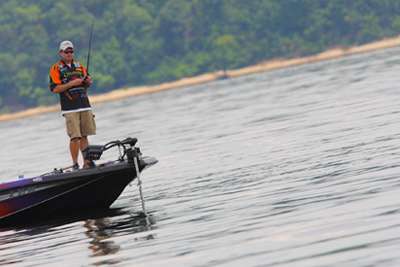
Like a quarterback picking apart a zone defense, Mike McClelland delivers his football jig with the same patience and precision.
A variety of bottom-bouncing baits will catch bass this time of year, but McClelland prefers throwing the football jig for his quick-strike offense. "The biggest thing about a football jig this time of year is the erratic action created by its head design," says McClelland, who relied on the jig to win the 2006 Sooner Run at Grand Lake and the 2007 Pride of Georgia at Clarks Hill.
"This time of year you really have to trigger fish into biting, and the way that football jig wobbles across the bottom, it creates action that a typical jig or Texas-rigged plastic worm just doesn't incorporate without the angler manipulating it." The Arkansas pro throws his football to a variety of targets. "The football jig can be fished on just about any hard bottom, whether it's shellbeds, rocks or gravel," he says. "If you're fishing lakes that don't have a hard bottom, then brushpiles, stumps and things like that are still primary places to fish a football jig."
A football jig can also be effectively delivered to all depth zones. "You can basically fish a football jig from 6 inches to 50 feet of water," says McClelland. "I have caught fish 45 to 48 feet deep on it." McClelland uses a 3/8-ounce model for shallow-water applications and a 1-ounce version for going deep, but most of the time he relies on football jigs in 1/2-, 5/8- and 3/4-ounce sizes.
The six-time BASS winner favors the Jewel Football Jig since it has a durable paint job and is equipped with an O'Shaughnessy hook that increases his fish-landing percentage. His favorite color this time of year is peanut butter and jelly/smoke. "I really prefer that color because so many fish are feeding on a variety of crawfish and shad," he says. "Since the bottom side is a smoke color, when the bait is falling it has kind of a translucent appearance (similar to a shad), but once the bait gets to the bottom, then the top side of the jig is peanut butter and jelly, so it takes on a crawfish appearance."
Zoom Brush Hogs and Zoom Baby Brush Hogs are McClelland's favorite trailers for his football jig. He wants his trailer to contrast the color of his football, so McClelland opts for a watermelon or watermelon purple creature bait if he thinks bass are keying on shad, and he picks a green pumpkin soft plastic if he perceives fish are feeding more on crawfish.
McClelland never modifies his football jig, but he will alter his trailer by trimming about 1/2 to 1 inch off the Brush Hog's body, pulling the side tentacles loose so the appendages dangle more and splitting the flappers to imitate crawfish pincers.
Keeping constant contact with the bottom is the key to McClelland's initial deliveries with the football jig. "There are times I will point my rod to the side or downward and just wind the bait until it is bouncing and rooting along the bottom," describes McClelland. "There are times I pause it when I come to an obstruction, shake it and gradually pull it over the bigger rock." A hopping retrieve also produces for McClelland once he has pinpointed fish.
"This time of year I am fishing for schools of fish," he says. After I catch one or two, the fish become more active so I start hopping the jig to get the fish to bite more aggressively. A lot of times you have to get that first bite on a slower, more methodical presentation, but after I get the first bite I hop it pretty hard (1 1/2 to 3 feet) off the bottom."
To complete his deliveries, McClelland throws his football jig on a 7-foot, 4-inch Falcon Mike McClelland Heavy Cover Finesse Jig Rod and Quantum PT SS baitcast reel filled with 20-pound Sunline Sniper FC Fluorocarbon for most situations, or 15-pound Sunline Sniper FC Fluorocarbon for clear water or if he wants a faster fall rate.





